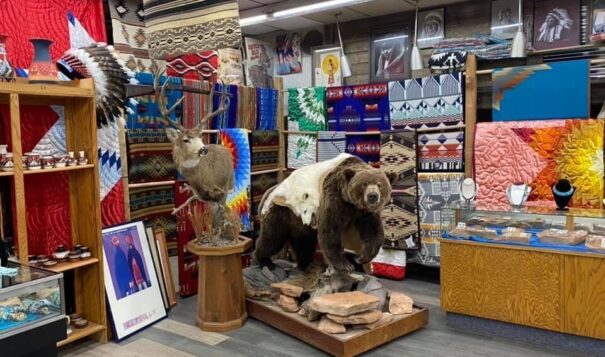News Based on facts, either observed and verified directly by the reporter, or reported and verified from knowledgeable sources.
Great Plains Indian Trading unveils venue In New Town, N.D.
 Ryan Wilson, the owner of Great Plains Indian Trading, is announcing his move to support Native business in New Town on Jan. 31. (Photo Courtesy of Great Plains Indian Trading)
Ryan Wilson, the owner of Great Plains Indian Trading, is announcing his move to support Native business in New Town on Jan. 31. (Photo Courtesy of Great Plains Indian Trading)
Native-run trading post to host celebration at store
A Native-run trading post on the Fort Berthold Reservation just bought a new building in the capital of the Mandan, Hidatsa and Arikara Nation. A celebration is planned Jan. 31. Live music, food and special guest speakers are expected to be on hand to welcome community involvement during the noon event at the store on Main Street in New Town, N.D. The event will be live-streamed on Facebook.
Ryan Wilson, an enrolled citizen of the Oglala Sioux Tribe, acquired the Super Value Grocery Building in New Town after a two-year-long purchase process, which included court-ordered receivership from the previous owner, Tracy’s Market. He told Buffalo’s Fire it was “a miracle” to complete the property purchase finally. The building will become the new Great Plains Indian Trading store where customers can purchase Northern Plains and Southwest art and products.
The business is solely Indian-owned and operated. Wilson and his six children have been running Great Plains Indian Trading since 2015. According to a press release, the goal for the business is to preserve the upper Missouri’s tribal lifeways, stories, ceremonies and culture through Indian art and material expressions.
While Indian trading posts have long been popular in the Great Plains and Southwest, few Natives own and operate these businesses. Tribal citizens own less than 3% nationwide, Wilson calculates.
Historically, non-Native settlers ran Indian trading posts, exploiting American Indian communities by unethically acquiring cultural goods. Great Plains Indian Trading aims to “challenge this controversial and dark history”.
Initially, Indian Trading posts operated as places of business and social hubs. Goods such as furs, rugs, baskets, jewelry, food and other supplies could be purchased or traded for other products or services.
Fort Union in Williston was one of the main fur trading posts along the upper Missouri River in North Dakota. American Indians from the Assiniboine and six other Northern Plains Tribes exchanged buffalo robes and smaller furs for goods from around the world, including cloth, guns, blankets, and beads. According to the National Park Service, Fort Union annually traded over 25,000 buffalo robes and $100,000 in merchandise.
The opening of Great Plains Indian Trading’s new venue exemplifies the activity envisioned in Gov. Doug Burgum’s Main Street Initiative. The four pillars of the North Dakota initiative include creating healthy and vibrant communities, a 21st-century workforce, efficient infrastructure and economic diversification.
In celebration, Great Plains Indian Trading set up the Jan. 31 event at noon in its 324 Main Street New Town building. It serves to announce the terms of the acquisition, celebrate the nine-year anniversary of Great Plains Indian Trading and highlight partnership in New Town’s main street development.
Special guests include North Dakota Native Tourism Alliance Board President Darian Morsette, wet plate collodion ambrotype photographer Shane Balkowitsch, International Champion Mandaree Singers and tribal leadership. The sponsors offered food and a raffle for door prizes.
Sourcing & Methodology Statement:
Houk, R. (2009, December 24). For 125 years, trading post has served community. NPR. https://www.npr.org/templates/story/story
Nez, L. (2022, July 7). Finding our Way Past Trading Posts. Asparagus Magazine. https://www.asparagusmagazine.com/articles/reimagining-indigenous-artifact-trading-posts-in-the-american-southwest
U.S. Department of the Interior. (n.d.). The Grandest Fort on the Upper Missouri River. National Parks Service. https://www.nps.gov/fous/index.htm
